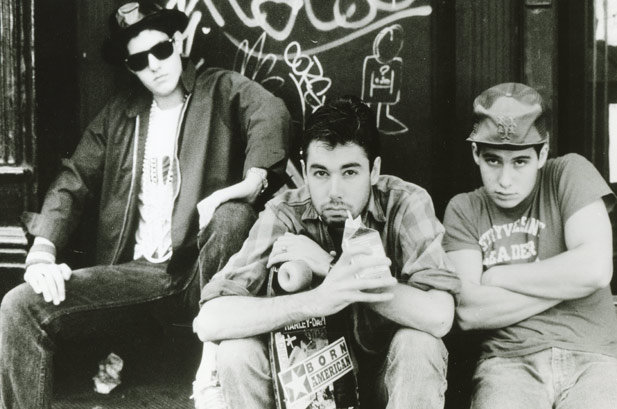Before their iconic records and the Hall of Fame induction, Beastie Boys were a punk band getting thrown out of White Castle. In the early 1980s Mike D, Ad Rock, and MCA were a riotous hardcore outfit who supported bands like Dead Kennedys and Bad Brains. Over time, however, their punk rock influence waned and their sound shifted to include more elements of hip hop. By 1986, under the watchful eye of producer Rick Rubin, Beastie Boys made the transition to full on rap outfit just in time for their debut album Licensed to Ill.
Released in 1986, thirty years ago this year, Licensed to Ill kept the screeching guitar riffs and scrappiness of their early EPs, but there are flickers of what came later. Its rudimentary, taking the “here’s three chords, now start a band” punk touchstone to hip hop. Early single ‘Fight for Your Right’ has cemented the Beasties to a place in the musical canon, but it’s ‘She’s Crafty’ that really demonstrates how much they would later develop. ‘She’s Crafty’ mixes punk rock guitar riffs with hip hop storytelling and industrial percussion. The narrative is adolescent, all sex, booze and parties gone wrong, but the instrumentals are a prelude to the mix and match style, they would develop more in future.
After Licensed to Ill, a royalty dispute with Def Jam and an ensuing estrangement from Rick Rubin sent the Beastie Boys packing to LA. Without Rubin at the desk the band teamed up with the Dust Brothers, to make Paul’s Boutique. The album kept all of the hedonistic hooliganism of Ill but gave it a sleeker, more industrial edge. Witness ‘Egg Man’, with its stabbing Psycho samples and slinky bass line. ‘Egg Man’ is a frat-boy boast about egging strangers from apartment building window, the brattish vocal delivered with a wicked Bart Simpson smirk. Here are the Beasties as seen on Licensed to Ill. But the composition is smoother than anything on their debut. ‘Egg Man’ carefully splices samples, funk bass and snotty lyrics together, setting the stage for the musical collage of their third album.
After a three-year gap Beastie Boys returned in 1992 with Check Your Head, which saw Mike D, MCA, and Ad Rock playing their own instruments on record for the first time since their early EPs. This reconnected them with their punk rock roots and added another layer to the cross-pollination of genres they were assembling on the album. Check Your Head chops and mixes elements the way ‘Egg Man’ touched on, but combines the process with a more measured lyrical tone. ‘Stand Together’ in particular gives a glimpse into the psyche of the maturing Beastie Boys. Rather than the juvenile humour and party chasing of their earlier work, ‘Stand Together’ takes a more considered and introspective approach as they explore their connection to the world and their investment in music. There are traces of the spirituality and politics that would appear in future work, backed by chopped-up, distorted guitar riffs and saxophone solos. But while ‘Stand Together’ showed the band taking tentative steps into self-reflection, it wasn’t until 1994’s Ill Communication that they truly embraced it.
Ill Communication marked a change for the Beasties. While the punk rock guitars and elementary, paint-by-numbers rhymes remain, they are less central to the genre-soup style the band were developing. They are also accompanied by snatches of more mature writing, with MCA declaring on ‘Sure Shot’; “well I want to say a little something that’s long overdue / the disrespect to women has got to be through.” He takes this introspection a step further on ‘Bodhisatta Vow’, using his platform to affirm his dedication to Buddhism. The rapid-fire vocal rhythm and record-scratch percussion are in sharp contrast to the Tibetan Monks’ chants that provide the track’s main musical backing, but rather than clashing each segment allows MCA to deliver a heartfelt affirmation in true Beasties style. ‘Bodhisatta Vow’ sees Beastie Boys wise up and settle down, and foreshadowed their later political activism – when MCA founded the Tibetan Freedom Concerts two years later, he did so under the banner of the Milarepa Fund, an organisation he originally created to distribute royalties to the Tibetan monks sampled on the track. While Beastie Boys never dispensed with the cheeky, smirking humour entirely – thankfully, lest they lose all their street-kid charm – after Ill Communications they continued to inject more socially conscious tracks into their work. Their fifth album Hello Nasty featured the two styles side by side, spitting out cocksure hip hop on lead single ‘Intergalactic’ and dropping down into throaty, mellow musings for tracks like ‘Song for the Man’. ‘Song for the Man’ took aim at the leering male masses, tackling sexism and street harassment atop a psychedelic Sgt Pepper’s-style instrumental. It’s a far cry from the toy-keyboard stylings of Licensed to Ill’s ‘Girls’ and ‘She’s Crafty’, showing just how the band’s worldview developed over a 12 year period. Their gentler approach carried on through to 2004’s To the 5 Boroughs, as they celebrated the multiculturalism of their hometown.
While up until this point the Beasties’ softer side was contained to album tracks and B-Sides, on To the 5 Boroughs they brought it front and centre with the single ‘An Open Letter to NYC’. The song deals with the city’s multiculturalism and still tender post-9/11 wounds with a sensitivity that never would have made it onto their earlier records. There was also a slight shift in sound, as the band returned briefly to rough-round-the-edges style hip hop. This sonic backtrack made their next step all the more unexpected, as their next record – the aptly named The Mix Up – consisted solely of instrumental compositions. The Mix Up was intended as a departure from the full-rap construction of To the 5 Boroughs and acts as a sort of musical pick’n’mix of the genres Beastie Boys had dabbled in. Overall the record is more laid-back than their earlier releases, with tracks like ‘4th Street Break’ dealing more in quiet psychedelia than snot-nosed punk or hip hop.
It’s almost as though the band were taking an afternoon off, lazing in the sun and gearing up for what was meant to be a two album follow up entitled Hot Sauce Committee Part 1 and Hot Sauce Committee Part 2. The two part idea was shelved when it became apparent that a number of factors, including MCA’s progressing cancer, would make the endeavour impossible. As a result only Hot Sauce Committee Part 2 was released before MCA’s death in 2012. Hot Sauce Committee is less socially focussed than their other later albums, with ‘Say It’s hidden barb “to help the man make weapons to monetise / corporate violence we can’t abide” proving the exception rather than the rule. Still, as the Beastie’s final album Hot Sauce Committee Part 2 is the culmination of three decades of genre-hopping, and remains a fitting testament to their legacy.
Over the course of their career, Beastie Boys were constantly challenging the restrictions of genre and style. Looking back over their catalogue, it’s easy to see why they remain such a vital part of the pop cultural landscape.




